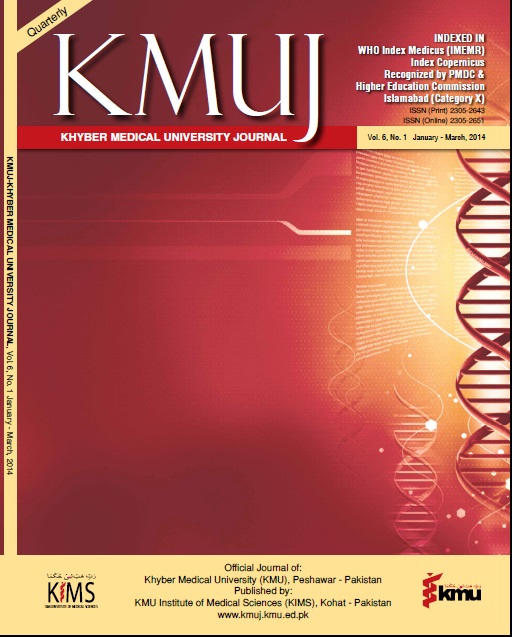USE OF KETAMINE PLUS MIDAZOLAM VERSUS KETAMINE ALONE IN PREVENTION OF SHIVERING DURING SPINAL ANAESTHESIA: A RANDOMIZED CONTROLLED TRIAL
Main Article Content
Abstract
OBJECTIVE: To compare the efficacy of combination of ketamine plus midazolam with that of ketamine alone in the prevention of shivering during spinal anaesthesia
METHODOLOGY: This double blinded randomized controlled clinical trial was carried out at institute of kidney diseases Hayatabad, Peshawar from 16 October 2012 to 15 April 2013. Two hundred patients, classified by American Society of Anesthesiologists (ASA) physical status category I-II, listed for urologic surgery were randomized by card method in two groups of 100 patients each. Subarachnoid (spinal) anaesthesia was performed in all patients with bupivacaine 15 mg. The patients were randomly allocated to receive ketamine 0.25 mg/kg plus midazolam 37.5 μg/kg (Group A) or ketamine 0.5 mg/kg (Group B). During surgery, a shivering score was recorded at 5 min intervals. If 15 minutes after spinal anaesthesia and concomitant administration of a prophylactic dose of one of the study drugs, grade 3 or 4 shivering was noted, the prophylaxis was regarded as ineffective and pethidine 25 mg intravenously was administered.
RESULTS: After 15 min, the incidences of shivering in groups A and B were 4% and 25% (P= <0.0001). Mean shivering score was 0.05±0.26112 and 0.43±0.87911 in group A and group B respectively. The number of patients with a shivering score of ≥3 was significantly higher in group B compared with groups A (4 vs. 0, respectively, P=0.0434).
CONCLUSION: Prophylactic use of ketamine (0.25 mg/kg) plus midazolam (37.5 μg/kg) intravenously was more effective than ketamine (0.5 mg/kg) intravenous alone in preventing shivering developed during spinal anaesthesia.
Article Details
Work published in KMUJ is licensed under a
Creative Commons Attribution 4.0 License
Authors are permitted and encouraged to post their work online (e.g., in institutional repositories or on their website) prior to and during the submission process, as it can lead to productive exchanges, as well as earlier and greater citation of published work.
(e.g., in institutional repositories or on their website) prior to and during the submission process, as it can lead to productive exchanges, as well as earlier and greater citation of published work.
References
De Whitte J, Sessler DI. Perioperative shivering: Physiology and pharmacology. Anaesthesiology 2002; 96(2): 467-84.
Katyal S, Tewari A,Sood D, Narula N, Garg S, Kaul TK. Shivering: Anesthetic considerations. J Anaesth Clin Pharmacol 2002; 18(4):363-76.
Mathews S, Al Mulla A, Varghese pk, Radim K, Mumtaz S. Postanaesthetic shivering- A new look at Tramadol. Anaesthesia 2002; 57: 387-403.
Hong JY, LeeIH. Comparison of the effects of spinal morphine and pethidine on shivering after Caesarean delivery under combined-spinal epidural anaesthesia. Anaesthesia 2005;60(12):1168-72.
Nasreen L, Muhammad NK, Namika N, Shahid K. Prevention of postoperative shivering by prophylactic ketamine in patients undergoing major surgeries under General Anesthesia. Ann Pak Inst Med Sci 2006;2(3):163-6.
Kose EA, Dal D, Akinci SB, Saricaoglu F, Aypar U. The efficacy of ketamine for the treatment of postoperative shivering. Anesth Analg 2008;106(1):120-2.
Weant KA, Martin JE, Humphries RL, Cook AM. Pharmacologic options for reducing the shivering response to therapeutic hypothermia Pharmacotherapy 2010;30(8):830-41.
Mohta M, Kumari N, Tyagi A, Sethi AK, Agarwal D, Singh M. Tramadol for prevention of postanaesthetic shivering: a randomized double-blind comparison with pethidine. Anaesthesia 2009;64:141–6.
Shukla U, Malhotra K, Prabhakar T. A comparative study of the effect of clonidine and tramadol on post-spinal anaesthesia shivering. Indian J Anaesth 2011;55(3):242-6.
Fatemeh J, Reza A, Kaveh BA, Alireza O, Mehrdad S. Effects of Tramadol on shivering, post spinal anesthesia in elective cesarean section. Pak J Med Sci 2009;25(1):12-7.
Yi JW, Lee BJ, Han JH. Effects of spinal meperidine on prevention of shivering during spinal anesthesia for herniorrhaphy. Korean J Anesthesiol 2005; 49:484–9.
Abdelrahman RS. Prevention of shivering during regional anaesthesia: Comparison of Midazolam, Midazolam plus ketamine, Tramadol, and Tramadol plus Ketamine. Life Sci J 2012; 9(2):132-9.
Crossley AWA, Mahajan RP. The intensity of postoperative shivering is unrelated to axillary temperature. Anaesthesia 1994;49:205–7.
Tsai YC, Chu KS. A comparison of tramadol, amitriptyline, and meperidine for
postepidural anesthetic shivering in parturients. Anesth Analg 2001;93:1288–92.
Hendolin H, Lansimies E. Skin and central temperatures during continuous epidural analgesia and general anaesthesia in patients subjected to open prostatectomy. Ann Clin Res 1982;14:181–6.
Frank SM, Beattie C, Chritopherson R, Norris EJ, Rock P, Parker S, et al. Epidural versus general anesthesia, ambient operating room temperature, and patient age as predictors of inadvertent hypothermia. Anesthesiol 1992; 77:252–7.
Matsukawa T, Sessler DI, Christensen R,Ozaki M, Schroeder M. Heat flow and distribution during epidural anesthesia. Anesthesiol 1995; 83:961–7.
Ozaki M, Kurz A, Sessler DI, Lenhardt R, Schroeder M, Moayeri A et al. Thermoregulatory thresholds during spinal and epidural anesthesia. Anesthesiol 1994; 81:282–8.
Dal D, Kose A, Honca M, Akinci B, Basgul E, Aypar U. Efficacy of prophylactic ketamine in preventing postoperative shivering. Br J Anaesth 2005; 95:189–92.
Sharma DR, Thakur JR. Ketamine and shivering. Anaesthesia 1990; 45:252–3.
Grover VK, Mahajan R, Yaddanapudi LN, Sudarshana HG, Gill KD. Efficacy of midazolam in preventing postoperative shivering. Int J Clin Pharmacol Ther 2002; 40:534–6.
Kurz A, Sessler DI, Annadata R, Dechert M, Christensen R, Bjorksten AR. Midazolam minimally impairs thermoregulatory control. Anesth Analg 1995; 81(2):393-8.
Hales JRS. Skin arteriovenous anastomoses, their control and role in thermoregulation. In: Cardiovascular Shunts: Phylogenetic, Ontogenetic and Clinical Aspects—Johansen K, Burggren W, eds. (1985) Copenhagen, Denmark:
Munksgaard. 433–51.
